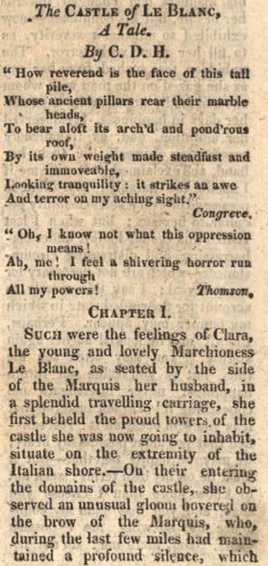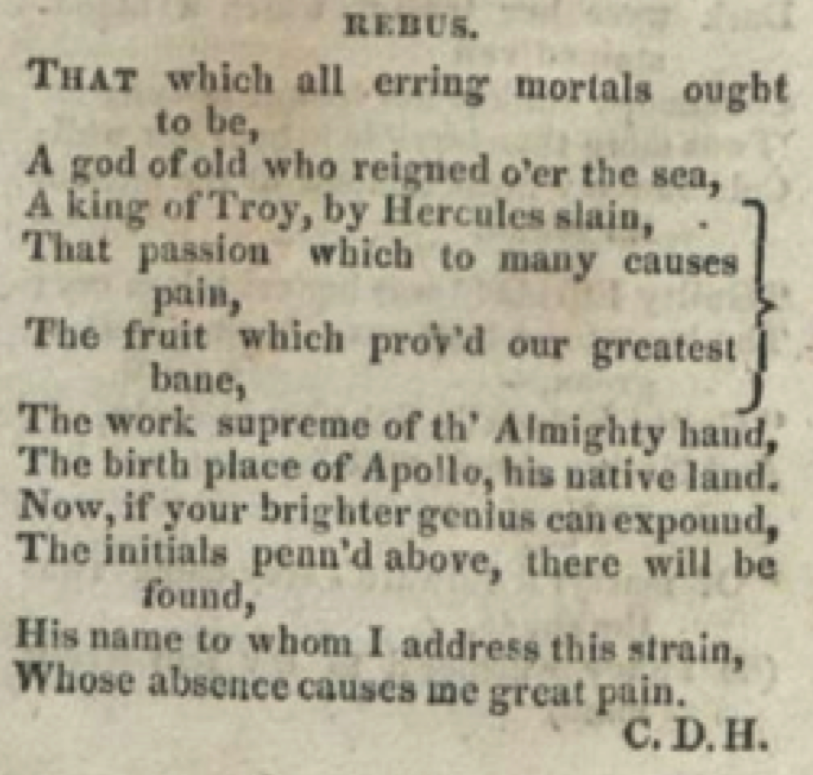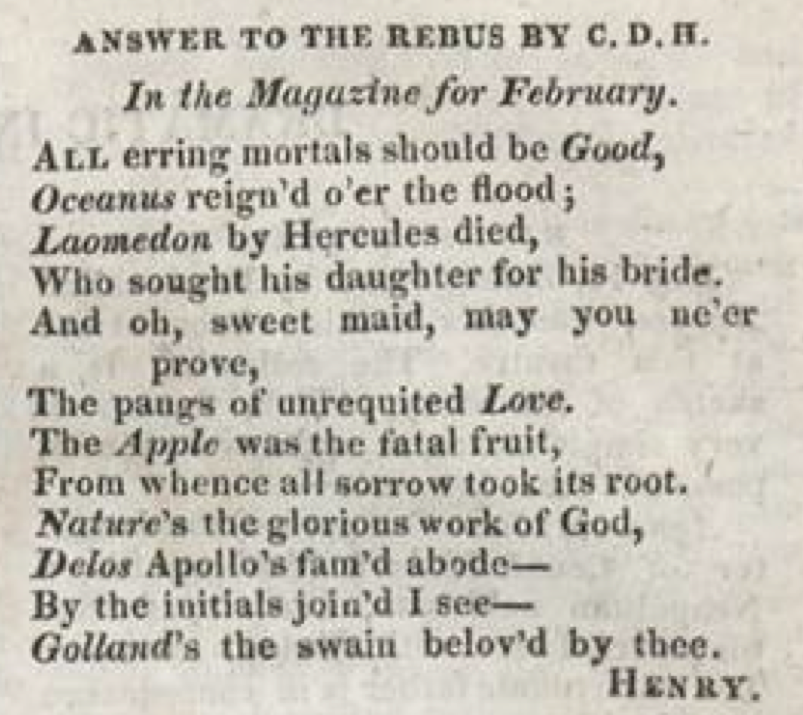Over thirty years into the lifespan of the Lady’s Magazine most of the magazine’s popular fiction remained the work of the anonymous, pseudonymous or often unsigned contributions of the periodicals’ reader/writers. Much of the content serialized in the magazine after 1800 closely resembles those popular Gothic novels published –and, importantly – paid for by the Minerva Press. And as we continue with our research, we uncover more authors who contributed to the Lady’s Magazine as unpaid correspondents and were paid for their works elsewhere.

LM XLVII (Oct 1816): 437. Image © Adam Matthew Digital / Birmingham Central Library. Not to be reproduced without permission
One of the correspondents who would become a paid writer published first in the Lady’s Magazine under the initials ‘C. D. H.’ According to The Cambridge Bibliography of English Literature, 1800-1900 [1] ‘C. D. H.’ is Miss C. D. Haynes, later Mrs C. D. Golland. Haynes published her first Gothic novel, The Castle of Le Blanc, A Tale, in serial form in the Lady’s Magazine from October 1816 through 1819.
This novel is really quite wonderful. It opens with a young bride, Clara, travelling to the castle of her new husband. On the journey he seems unaccountably agitated and cold but when she asks him about his odd behavior he forbids her to question him. When they reach his ancestral home: ‘the ponderous gate of the castle opened to receive them—a cold shivering ran through the frame of Clara; she viewed it as the grave of the departed happiness’ (LM XLVII [Oct 1816]: 439). The novel takes on a Radcliffean tone, interweaving Gothic conventions found in The Italian and The Mysteries of Udolpho. Clara, pregnant and alone in the castle with her husband the Marquis le Blanc is desperately unhappy as he ‘made too free with the bottle after dinner’ and ‘generally joined her quite inebriated’ (LM XLVIII [Aug 1817]: 357). The novel’s inset tale features with gambling, ruin, a beautiful siren, and a virtuous heroine who cross-dresses as a gamester to successfully win her lover’s fortune from him rather than see him lose it to his enemies.

LM XLVIII (Feb 1817): 88. Image © Adam Matthew Digital / Birmingham Central Library. Not to be reproduced without permission
What I find so interesting about C. D. Haynes, who I believe is in fact Catharine Day Haynes, later Catharine Day Golland, is her relationship with the Lady’s Magazine. Because not only did Catharine Haynes publish her first Gothic novel in the magazine, she also contributed other items, such as a rebus in February 1817 that was solved in June. The solution to the rebus was posed by a correspondent with the signature ‘Henry’ who answered the riddle with: ‘Golland’s the swain belov’d by thee’ (LM XLVIII [June 1817]: 233). Part of Catharine’s courtship then, or at least her publication of it, was conducted within the very pages of the periodical.

LM XLVIII (June 1817): 233. Image © Adam Matthew Digital / Birmingham Central Library. Not to be reproduced without permission
Catharine went on to publish a number of novels with the Minerva Press, and the first two of these were actually printed in 1818 and 1819 – while she was still writing The Castle of Le Blanc for the Lady’s Magazine. Clearly her paid work did not stop her from writing unpaid for the magazine. Her Minerva Press novels include The Foundling of Devonshire, or who is she? (1818) Augustus and Adeline, or, the monk of St. Barnardine: a romance (1819), Eleanor, or the Spectre of St. Michaels: a romantic tale (1821, tr. Fr. 1824).
But even after such successes with the Minerva Press, Catharine Haynes’ relationship with the Lady’s Magazine endured. The magazine’s births, marriages, and deaths section published her nuptials to ‘the swain Golland’ in January 1821: ‘At St. Bride’s, Mr. John Golland, of the New Kent Road, to Miss C. D. Haynes, author of the Castle Le Blanc, Foundling of Devonshire, and several other works’ (LM II [Jan 1821]: 56).

LM III (April 1822): 224. Image © Adam Matthew Digital / Birmingham Central Library. Not to be reproduced without permission
Interestingly, the Magazine notes not only the Gothic tale she wrote for them, but also her publication with Minerva. Little more than a year later, Catharine Haynes – now Golland – is mentioned again in the same section, but this time it is a birth that is announced: ‘a daughter born to the wife of Mr. John Golland, in the New-Kent-road,–formerly Miss Haynes, authoress of the Castle of le Blanc, a novel given in our Magazine’ (LM III [April 1822]: 224).
But the Robinsons’ loyalty to Mrs Golland ends here. In 1822, after she has published two novels with the Minerva Press, Catharine sends another novel, likely unsolicited and provided free of charge, to the editors of the magazine. The novel was clearly not well received. In the Noember 1822 column ‘To our correspondents’ the editors state that:

LM III (November 1822): 640. Image © Adam Matthew Digital / Birmingham Central Library. Not to be reproduced without permission.
What this indicates, I believe, is that contributors to the magazine were not amateur or unprofessional as they have often been described by literary historians such as Robert Mayo.[2] They were skilled and professional writers who published work elsewhere that was paid for and in some cases returned to the magazine to continue to provide – or attempt to provide – further original fiction with no payment expected. Catharine Haynes Golland is just one example of those correspondents whose literary career fails to conform to the model of authorship as a linear progression from the amateur to professional.
[1] Joanne Shattock, The Cambridge Bibliography of English Literature, 1800-1900 (Cambridge: Cambridge University Press, 1999), pp. 929-30.
[2] Robert D. Mayo, The English Novel in the Magazines, 1740-1815 (London: Oxford University Press, 1962), p. 2; p. 81; p. 317.
Dr Jenny DiPlacidi
University of Kent

cdh bapt. 18 August 1793, St Bartholomew the Great, Smithfield, London, m. John Golland 6 January 1821, St. Bride’s, Fleet Street, London, buried Stepney 20 April 1851, aged 56, etc etc.